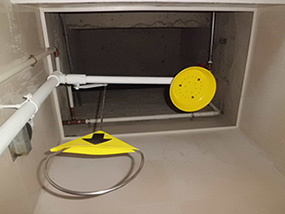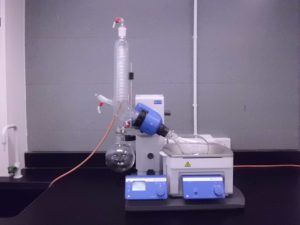| Location | E11-3092 |
| Academic Staff in charge | Prof. Weng Fai IP, Andy |
| Technician | Seng LEONG, John |
| Open Access Reservation Period | Monday: 10:00 – 12:00 Wednesday: 15:00 – 17:00 Thursday: 10:00 – 12:00, 15:00 – 17:00 |

CHEMISTRY LABORATORY
Objective
- Provide teaching laboratory/facilities for UG programmes offered by FST;
- Provide support (laboratory) for UG programmes offered by FED & ESFSM (Police school);
- Provide laboratory/facilities for PG programmes offered by FST
- Support chemistry related laboratory teaching approved by the University
Facilities
The chemistry laboratory is equipped with basic measuring and analytic equipment,
such as: balances ranging from 0.01g to 0.0001g, pH meter, microscope water deionizer and Melting point apparatus.

EYE WASHER

SAFETY SHOWER

FUME CUPBOARD
Equipment
ROTARY EVAPORATOR

OVEN
TEMPERATURE RANGE: MINIMUM 5°C ABOVE
AMBIENT UP TO +300°C
TEMPERATURE RANGE: MINIMUM 5°C ABOVE
AMBIENT UP TO +300°C

HOT PLATE WITH STIRRER
TEMPERATURE RANGE: 5 TO 540°C
TEMPERATURE RANGE: 5 TO 540°C

HOT BATH
TEMPERATURE RANGE: UP to +95 °C
TEMPERATURE RANGE: UP to +95 °C

TOP BALANCE: 3000g ± 0.01g

ANALYTIC BALANCE: 200g ± 0.0001g

CENTRIFUGE
FREQUENCY OF ROTATION
RANGE: 0 TO 3.2 x 1000 RPM
FREQUENCY OF ROTATION
RANGE: 0 TO 3.2 x 1000 RPM

SPECTROPHOTOMETER
EFFECTIVE MEASURING WAVELENGTH:
335 TO 1000 nm
EFFECTIVE MEASURING WAVELENGTH:
335 TO 1000 nm

DC POWER SUPPLY
ADJUSTABLE OUTPUTS:
0-18V AND 0-3A
ADJUSTABLE OUTPUTS:
0-18V AND 0-3A
Experiments
| Exp’t | Experiment Theme | Minimum Required Equipment | Learning Outcomes |
| 1. | Introduction to chemistry lab | Fumehood (3 sets) | Students become familiar with chemistry laboratory safety. |
| 2. | Basic laboratory techniques | Basic lab glassware; balance (3 sets) | Operation of basic lab glassware, Bunsen burner, distilled water supply; accuracy and precision; units |
| 3. | Limited reactants | Basic lab glassware, water aspirator | Simple synthesis; operation of low vacuum filtration system; reaction stoichiometry |
| 4. | Aluminum analysis | Gas collection apparatus (12 sets) | Creativity development; report writing; ideal gas law |
| 5. | La Chatilier’s principle | Glassware | Chemical equilibrium; chemical dynamics; observation training |
| 6. | pH, hydrolysis and buffers | pH meter (1 set), pH paper, | Acid & base principle; comparison of various means of pH determination |
| 7. | Standardization of a base | Burette (12 sets) | Operation of a burette; control and patience |
| 8. | Faraday’s law | AC transformer (10 sets) | Electrochemistry; corrosion; observation and creativity training |
| 9. | Organic functional group analysis | Waterbath (1 set), heating plates (3 sets) | Reinforcement of ideas in organic functional groups |
Courses supported
| CHEM112 | General Chemistry |
| Chemistry (ESFSM) | |



